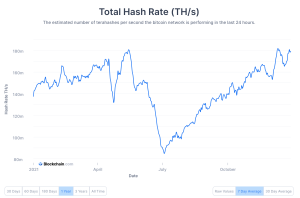The Bitcoin hashrate hit all-time highs in December despite recent price drops from previous highs.
Price down, hashrate up
Bitcoin investors have not had it easy in December. As most analysts were expecting a bullish final quarter of the year, crypto bulls were getting ready for new all-time highs in December, with some penciling in a similar blow-off top to 2017. $100,000 USD was on the cards for more than one Bitcoin bull, but those hopes were dashed after skyrocketing inflation spurred the US Federal Reserve into action over its loose monetary policy. Since, Bitcoin prices have firmly consolidated below $70,000 AUD, and bulls have to console themselves with the fact that they are still in a much better shape than during the summer dip.
Good news is coming from the mining sites, though. The network’s hashrate reached a new all-time high on December 8 at 194.95 exahash per second. As a reminder: the Bitcoin hashrate is the aggregated computing power that goes into mining new coins. As the supply of new coins decreases, mining becomes more difficult, and the hashrate needs to rise to keep up with it. A rising hashrate is thus considered a bullish indicator, as it signals increasing interest in mining new coins despite the greater difficulty and attached financial cost. Although the days of retail bitcoin mining are long gone, large-scale industrial bitcoin mining is still booming.

Source: Blockchain.com
The network’s hashrate had hit a lifetime high previously on May 9, shortly after the asset recorded its spring all-time high. between May and now, the Bitcoin network saw a sharp reduction in its hashrate, mainly due to a miner exodus out of China, which banned bitcoin mining for good. Most miners found refuge in neighbouring countries, but surprisingly, the United States is now leading the Bitcoin network in hashrate.
This is all the more surprising as the difficulty of mining bitcoin has recently reached an all-time high. Previously, it was as difficult to mine Bitcoin as on May 13, shortly after the previous hashrate all-time high.
What does this mean for Bitcoin prices?
Although mining and Bitcoin prices are not directly related, they are not independent of each other either. As the price of Bitcoin increases, new miners join the game since profit margins increase with higher prices. Upon a price drop, some exit, but not all do. Bitcoin mining is mostly organised in mining pools. Price drops can lead to pool consolidation as bigger pools gobble up the hardware of smaller ones that cannot operate on tighter profit margins. That is one reason why mining BTC has become a de facto oligopoly, with a few miners controlling a majority of the network’s hashrate.
Thus an increase in computing power indicates that miners are currently profitable or expect to be so soon. Were the price to rise, new miners would start mining, increasing the hashrate, which further strengthens the network. Good news indeed for investors, who are anticipating a rocky 2022 for crypto assets.












